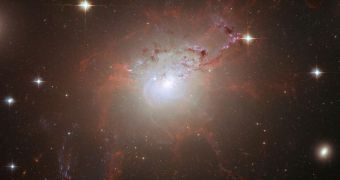In a new study, experts were finally able to determine the power source that is heating up that gas filaments spawned by the elliptical galaxy NGC 1275. This has been the focus of studies for quite some time now, but results thus far have been conflicting.
Over years of study, astronomers have discovered that certain massive elliptical galaxies have very large filaments stretching out from their cores. These gaseous structures sometimes have immense proportions, and some do not immediately reveal their power sources.
Such was the case with NGC 1275, whose filaments, while extremely long, are very narrow. Spanning more than 20,000 light-years in length, nearly one fifth of Milky Way's diameter, they are only 200 light-years in diameter.
In other galaxies, the structures are heated up and made to glow by nearby, star-forming regions, which produce new stellar objects at a frantic pace. But this is not the case in this particular object, which is located relatively nearby, in the constellation of Perseus.
Previous spectral analysis of the filaments revealed the presence of molecules such as carbon monoxide and H2, which is unusual for such structures. In fact, astronomers said, these formations provide readings similar to the ones collected from the Crab Nebula supernova remnant.
Spectral readings also indicate that the molecular gas is cooler than the surrounding gas, which means that the tendrils should have collapsed on themselves due to gravity eons ago, which did not happen.
One explanation for this might be the presence of ionized plasma around the filaments. The plasma is heating up the gas, balancing out the gravitational pull. But the problem with this proposal is that it's hard to believe the two forces are balancing each other out perfectly.
Furthermore, it's also unlikely that this happens in every single elliptical galaxy out there that produces gas filaments. Back in 2008, experts proposed in the top journal Nature that weak magnetic fields were preventing the plasma from mixing with the gas.
In the new investigation, carried out by the same time, the experts propose that only some plasma particles make their way into the gas filaments, in sufficient amounts to account for the heating telescopes observe, Universe Today reports.
However, the new explanation does not account for the flux of X-rays that investigators found emanating from the tendrils. The study does indicate that some radiations form as a result of the plasma-gas interactions, but the hypothesized amounts are much lower than what is visible on the spectra.

 14 DAY TRIAL //
14 DAY TRIAL //